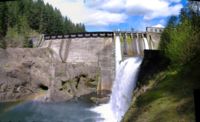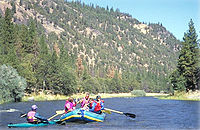Dam removal
The examples and perspective in this United States may not represent a worldwide view of the subject. |

Dam removal is the process of removing out-dated, dangerous, or ecologically damaging dams from river systems. There are thousands of out-dated dams in the United States that were built in the 18th and 19th centuries, as well as many more recent ones that have caused such great ecological damage, that they are proposed for removal.
Catastrophic dam failures such the 1976 Teton Dam failure in Idaho, the 1928 St. Francis Dam failure in California, and the 1889 Johnstown Flood remind people of the dangers dams can present. The largest catastrophic failure of a dam was the 1975 Banqiao Dam disaster that killed 26,000 people immediately, resulted in 145,000 dying of disease later, and displacing 11,000,000 residents.
Purposes and Effects of Dams

Many of the dams in the eastern U.S. were built for water diversion, agriculture, factory watermills, and other purposes that are no longer useful. Because of the age of these dams, over time the risk for catastrophic failure increases. In addition, many of these dams block anadromous fish runs, such as Atlantic salmon and American shad, and prevent important sediments from reaching estuaries.
Many dams in the western U.S. were built for agricultural water diversion in the arid country, with hydroelectric power generation being a very significant side benefit. Among the largest of these water diversion projects is the Columbia Basin Project, which diverts water at the Grand Coulee Dam. The Bureau of Reclamation manages many of these water diversion projects.
Dams in the Pacific Northwest and California block passage for anadromous fish species such as Pacific Salmon and Steelhead. Fish ladders and other passage facilities have been largely ineffective in mitigating the negative effects on salmon populations. Bonneville Power Administration manages electricity on 11 dams on the Columbia River and 4 on the Snake River, which were built by the Army Corps of Engineers.

In the Desert Southwest, dams can change the very nature of the river ecosystem. In the particular case of the Glen Canyon Dam, the originally warm, sediment-filled, muddy water, instead runs cold and clear through the Grand Canyon, which has significant impacts on the downstream ecosystems. Three native fish species have become extinct in the Grand Canyon and others are endangered since the dam was completed, including humpback chub and razorback sucker.

Some dam projects, such as those on the Salt River Project in Arizona, literally eliminate the flow of the river downstream, by diverting the flow into the Arizona Canal system for use in agriculture and urban usage, such that only a dry channel or arroyo (creek) heads out across the desert.
So much water is taken out of the Colorado River for agriculture, urban use, and evaporation behind the dams, that the river no longer flows into the Gulf of California.
While the need for clean, alternative energy sources are important, with so many considerations involved, sometimes it makes sense to evaluate whether the benefits of dams outweight the costs of safety concerns, ecosystem functions, and management expenses.
Major dam removal projects
Elwha Ecosystem Restoration Project
The largest dam removal project in history is the Elwha Ecosystem Restoration project on the Olympic Peninsula of Washington. In 2012, the 108 ft (33 m) Elwha Dam and the 210 ft (64 m) Glines Canyon Dam will be removed to restore anadromous stocks of Pacific Salmon and trout species to the Elwha River watershed. The removal of these blockades will allow migratory salmon to travel past the dams and upriver, an event that has not occurred since the dams' creation in 1913. Salmon reintroduction will allow for marine nutrients to return to the upper river beds as the salmon end their life cycles, providing a valuable research opportunity for interested parties.[1]
Savage Rapids Dam
The Savage Rapids Dam on the Rogue River in Oregon was built for agricultural water diversion. It was removed by the Bureau of Reclamation in 2009 due to its out-dated facilities and non-functioning fish ladders that prevent fish migration past the dam.
Marmot Dam Removal
The 50 ft (15 m) Marmot Dam on the Sandy River in Oregon was removed in 2007 by Portland General Electric. It has been an extremely successful project which has improved access for anadromous Pacific Salmon and Steelhead to access the upper Sandy River watershed up into the Mount Hood Wilderness.
Lewiston Dam Removal

The 39 ft (12 m) Lewiston Dam in Idaho was removed in 1973. It was built in 1927 as a hydroelectric facility, but lacked fish ladders originally. Upon completion of the Lower Granite Dam and its reservoir, the lack of gradient on the river made it obsolete. Its removal improved salmon runs on the river.
Edwards Dam Removal
The 24 ft (7.3 m) Edwards Dam on the Kennebec River in Maine was removed in 1999. Built in 1837, it blocked access to anadromous Atlantic Salmon and American Shad. Landmark case in which a federal agency required the decommissioning and removal of a dam against operator's wishes.
Marie Dorian Dam Removal
The 8 ft (2.4 m) Marie Dorian Dam on the Walla Walla River in Oregon was removed in 1997. It blocked passage to anadromous Pacific Salmon and Steelhead into the Blue Mountains from the Columbia Basin.
Dams which have been discussed for removal
White Salmon River Dams
The 123 ft (37 m) Condit Dam on the White Salmon River in Washington blocks access for anadromous Pacific Salmon and Steelhead runs on 33 miles (53 km) of river. PacifiCorp proposed to remove the dam, with the support of the environmental community. It was proposed for removal in 2006, but actions from Skamania and Klickitat counties have held up the process. In fall 2008, salmon will be trucked up above to dam to allow them to spawn higher up the river. In 2009, PacifiCorp will punch a 15-foot (4.6 m) hole in the dam to drain the reservoir and allow young salmon to enter the Columbia River and head to sea.
Lower Snake River Dams
The lower four Snake River dams including the 100 ft (30 m) Lower Granite Dam, 98 ft (30 m) Little Goose Dam, 100 ft (30 m) Lower Monumental Dam, and 100 ft (30 m) Ice Harbor Dam. These dams, built by the United States Army Corps of Engineers, serve as hydroelectric power sources as well as ensuring agricultural barge traffic navigation to Lewiston, Idaho.
-
Lower Granite Dam
-
Little Goose Dam
Rindge Dam
The 100 ft (30 m) Rindge Dam on Malibu Creek in the Santa Monica Mountains of California was built in 1924 and today is completely filled with sediment, making it obsolete. Malibu Creek once supported the southermost Steelhead population in the world. But, today the Steelhead no longer occupy the creek.
-
Rindge Dam on Malibu Creek
-
Malibu Creek in Malibu Canyon
Klamath River Dams
Four dams on the Klamath River including the J.C. Boyle, Copco No. 1, Copco No. 2, and Iron Gate dams. These dams are operated by PacifiCorp and are up for relicensing. In addition to blocking anadromous salmon runs, the reservoirs that form behind the dams built up extremely high levels of toxic algal blooms.
On September 29, 2009, a tentative agreement was reached to remove the four dams; if the plan proceeds they will be dismantled starting in 2020.[1]
Glen Canyon Dam
The 710 ft (220 m) Glen Canyon Dam has been proposed for removal because of the negative effects it has on the water quality and riparian habitat of the Colorado River in Grand Canyon National Park. In addition, the reservoir impounded behind it, Lake Powell has filled all of the canyons for up to 100 miles (160 km) above the dam. This lake, while providing recreational opportunities, has eliminated more than 100 miles (160 km) of habitat for endangered Colorado River fish species. If it were to be removed, it would dwarf any dam removal project in history.
-
Glen Canyon Dam
-
Lake Powell behind Glen Canyon Dam
-
Glen Canyon below the dam
See also
References
- ^ Fimrite, P. Deal to raze 4 Klamath dams. San Francisco Chronicle 30 September 2009.
External links
- Elwha River Dam Removal Study
- Dam Removal Success Stories:Restoring Rivers through Selective Removal of Dams that Don't Make Sense
- Portland General Electric Marmot Dam
- Army Corps of Engineers Dam Removal Page
- Friends of the Earth River Restoration Page
- DRM Removal
- Spotify Ripper
- Natural Resources Council of Maine Kennebec River Restoration
- Spot.us - Story: The Story Behind the World's Biggest Dam Removal - Rough Water









